广告英语的特点及翻译策略
广告英语语言特点及其翻译策略
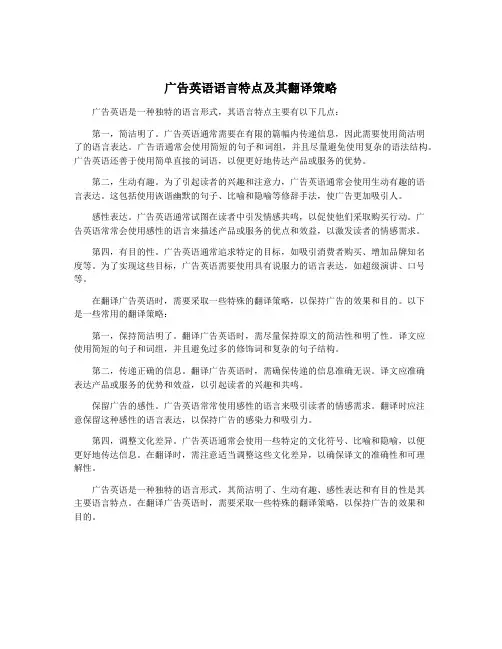
广告英语语言特点及其翻译策略广告英语是一种独特的语言形式,其语言特点主要有以下几点:第一,简洁明了。
广告英语通常需要在有限的篇幅内传递信息,因此需要使用简洁明了的语言表达。
广告语通常会使用简短的句子和词组,并且尽量避免使用复杂的语法结构。
广告英语还善于使用简单直接的词语,以便更好地传达产品或服务的优势。
第二,生动有趣。
为了引起读者的兴趣和注意力,广告英语通常会使用生动有趣的语言表达。
这包括使用诙谐幽默的句子、比喻和隐喻等修辞手法,使广告更加吸引人。
感性表达。
广告英语通常试图在读者中引发情感共鸣,以促使他们采取购买行动。
广告英语常常会使用感性的语言来描述产品或服务的优点和效益,以激发读者的情感需求。
第四,有目的性。
广告英语通常追求特定的目标,如吸引消费者购买、增加品牌知名度等。
为了实现这些目标,广告英语需要使用具有说服力的语言表达,如超级演讲、口号等。
在翻译广告英语时,需要采取一些特殊的翻译策略,以保持广告的效果和目的。
以下是一些常用的翻译策略:第一,保持简洁明了。
翻译广告英语时,需尽量保持原文的简洁性和明了性。
译文应使用简短的句子和词组,并且避免过多的修饰词和复杂的句子结构。
第二,传递正确的信息。
翻译广告英语时,需确保传递的信息准确无误。
译文应准确表达产品或服务的优势和效益,以引起读者的兴趣和共鸣。
保留广告的感性。
广告英语常常使用感性的语言来吸引读者的情感需求。
翻译时应注意保留这种感性的语言表达,以保持广告的感染力和吸引力。
第四,调整文化差异。
广告英语通常会使用一些特定的文化符号、比喻和隐喻,以便更好地传达信息。
在翻译时,需注意适当调整这些文化差异,以确保译文的准确性和可理解性。
广告英语是一种独特的语言形式,其简洁明了、生动有趣、感性表达和有目的性是其主要语言特点。
在翻译广告英语时,需要采取一些特殊的翻译策略,以保持广告的效果和目的。
广告英语的语言特色
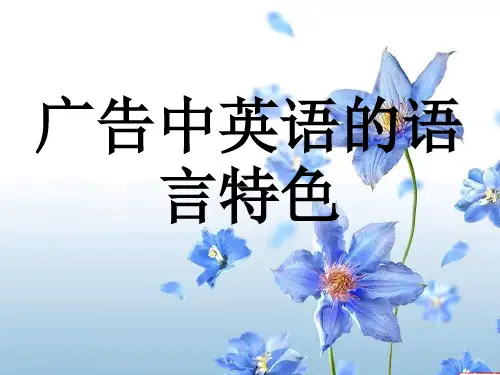
四、广告英语的翻译策略 任何商务广告的最终目的都是为了销售商品,广告英语翻译的目 的也不例外。一般来说,广告英语翻译应遵从促销力 、创意、美感、文 化适宜性这样一个四要素标准。 根据这一标准,广告英语翻译策略主要有以下几种。
1.直译 (Literal Translation) 直译又称语义翻译(Semantic Translation)或异化翻译 (Foreignisation Translation)。直译 指的是把原来语言的语法结构转换为译文语言中最近似的对应结构, 但词汇依然一一对译,不考虑上下文。异化翻译较多地保留了英语的句 式结构和表达方式,较少考虑目标受众的阅读习惯和理解方式。试比较 下例: To kill two birds with one stone. 一石两鸟 (异化翻译) 一箭双雕 (归化翻译)
1.比喻(figure of speech)。比喻能使广告语言生动形象,增强读 者的形象思维.如Featherwater. Light as a feather. (Featherwater 牌眼镜广告);Like a good neighbor, State Farm is there.(农场 保险公司广告)。 2.拟人(Personification)。拟人法可使广告语言更加生动、活泼, 富有情趣;赋予无生命的商品以人的思想感情和动作,使之人格化,变得 具有人情味,缩短广告商与读者之间的心理距离,给消费者一种可信赖 感和亲切感。如:The world smiles with Reader's Digest.(《读者文 摘》给世人带来欢乐);再如Peony stands out for taste.( 牡丹香烟, 醇味盖冠).
广告中英语的语 言特色
广告不仅要把商品信息传递给消费者, 而且要把美感、情感传递给消费者。广告 集社会学、美学、心理学、市场营销学、 声电学、文学、语言学等于一身,是一门 综合性艺术。在激烈的商品市场竞争中, 广告要以新颖别致的词汇,言简意赅的语 句和生动有趣的修辞手法,才能博得消费 者对商品的信赖和喜爱。广告英语作为一 种相对独具特色的应用性语言,在修辞方 面具有很多特色。我们就从广告英语中的 词法特点、句法特点及修辞手段等进行分 析。
英语广告词的修辞艺术与翻译策略
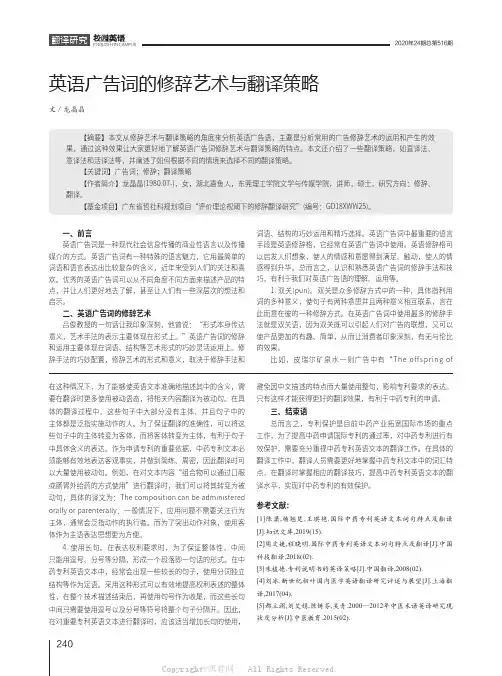
2402020年24期总第516期ENGLISH ON CAMPUS英语广告词的修辞艺术与翻译策略文/龙晶晶词语、结构的巧妙运用和精巧选择。
英语广告词中最重要的语言手段是英语修辞格,它经常在英语广告词中使用。
英语修辞格可以启发人们想象,使人的情感和意愿得到满足、触动,使人的情感得到升华。
总而言之,认识和熟悉英语广告词的修辞手法和技巧,有利于我们对英语广告语的理解、运用等。
1. 双关(pun)。
双关是众多修辞方式中的一种,具体指利用词的多种意义,使句子有两种意思并且两种意义相互联系,言在此而意在彼的一种修辞方式。
在英语广告词中使用最多的修辞手法就是双关语,因为双关既可以引起人们对广告的联想,又可以使产品更加的有趣、简单,从而让消费者印象深刻,有无与伦比的效果。
比如,皮瑞尔矿泉水一则广告中有“The offspring of 一、前言英语广告词是一种现代社会信息传播的商业性语言以及传播媒介的方式。
英语广告词有一种特殊的语言魅力,它用最简单的词语和语言表达出比较复杂的含义,近年来受到人们的关注和喜欢。
优秀的英语广告词可以从不同角度不同方面来描述产品的特点,并让人们更好地去了解,甚至让人们有一些深层次的想法和启示。
二、英语广告词的修辞艺术吕俊教授的一句话让我印象深刻,他曾说:“形式本身传达意义,艺术手法的表示主要体现在形式上。
”英语广告词的修辞和运用主要体现在词语、结构等艺术形式的巧妙灵活运用上。
修辞手法的巧妙配置,修辞艺术的形式和意义,取决于修辞手法和【摘要】本文从修辞艺术与翻译策略的角度来分析英语广告语,主要是分析常用的广告修辞艺术的运用和产生的效果,通过这种效果让大家更好地了解英语广告词修辞艺术与翻译策略的特点。
本文还介绍了一些翻译策略,如直译法、意译法和活译法等,并阐述了如何根据不同的情境来选择不同的翻译策略。
【关键词】广告词;修辞;翻译策略【作者简介】龙晶晶(1980.07-),女,湖北嘉鱼人,东莞理工学院文学与传媒学院,讲师,硕士,研究方向:修辞、翻译。
广告英语翻译及特点
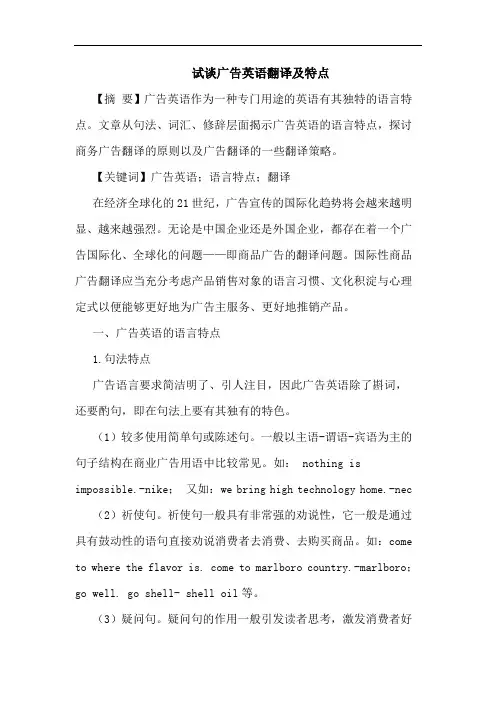
试谈广告英语翻译及特点【摘要】广告英语作为一种专门用途的英语有其独特的语言特点。
文章从句法、词汇、修辞层面揭示广告英语的语言特点,探讨商务广告翻译的原则以及广告翻译的一些翻译策略。
【关键词】广告英语;语言特点;翻译在经济全球化的21世纪,广告宣传的国际化趋势将会越来越明显、越来越强烈。
无论是中国企业还是外国企业,都存在着一个广告国际化、全球化的问题——即商品广告的翻译问题。
国际性商品广告翻译应当充分考虑产品销售对象的语言习惯、文化积淀与心理定式以便能够更好地为广告主服务、更好地推销产品。
一、广告英语的语言特点1.句法特点广告语言要求简洁明了、引人注目,因此广告英语除了斟词,还要酌句,即在句法上要有其独有的特色。
(1)较多使用简单句或陈述句。
一般以主语-谓语-宾语为主的句子结构在商业广告用语中比较常见。
如: nothing is impossible.-nike;又如:we bring high technology home.-nec (2)祈使句。
祈使句一般具有非常强的劝说性,它一般是通过具有鼓动性的语句直接劝说消费者去消费、去购买商品。
如:come to where the flavor is. come to marlboro country.-marlboro;go well. go shell- shell oil等。
(3)疑问句。
疑问句的作用一般引发读者思考,激发消费者好奇心。
如:do you…yahoo?-yahoo; where’s the beef?-wendy’s;hungry? grab a snickers” - snickers; same time tomorrow?”- diet pepsi等。
2.词汇特点广告因其本身的商业特点,在词汇的选择上除商品本身特点需选用特殊词汇外,大多通俗易懂,比较口语化。
有时还追求耳目一新,吸引消费者眼球,使其增强广告记忆,加深产品印象。
An Analysis of Translating Strategies of Advertisement English
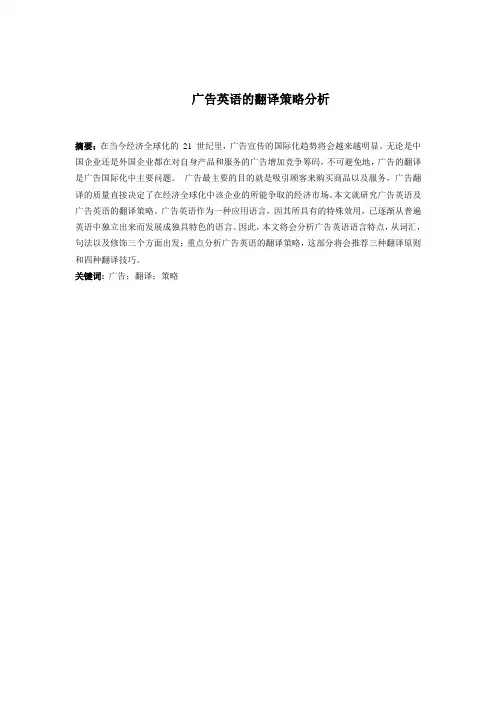
广告英语的翻译策略分析摘要:在当今经济全球化的21 世纪里,广告宣传的国际化趋势将会越来越明显。
无论是中国企业还是外国企业都在对自身产品和服务的广告增加竞争筹码,不可避免地,广告的翻译是广告国际化中主要问题。
广告最主要的目的就是吸引顾客来购买商品以及服务,广告翻译的质量直接决定了在经济全球化中该企业的所能争取的经济市场。
本文就研究广告英语及广告英语的翻译策略。
广告英语作为一种应用语言,因其所具有的特殊效用,已逐渐从普遍英语中独立出来而发展成独具特色的语言。
因此,本文将会分析广告英语语言特点,从词汇,句法以及修饰三个方面出发;重点分析广告英语的翻译策略,这部分将会推荐三种翻译原则和四种翻译技巧。
关键词:广告;翻译;策略An Analysis of Translating Strategies of AdvertisementEnglishAbstract: In modern 21st century of economic globalization, the trend of internationalization of advertisement promotion has increasingly taken up an indispensable role in the fight of global market. Both Chinese and foreign market has flexed their nerve to better the advertisement of their product and services. While there is no denial that advertisement translation is one of the inevitably issues which should be handled in the internationalization of advertisement promotion. Admittedly, the basic purpose of advertisement is to attract potential consumers to buy the product or service advertised in the advertisement, so the quality of advertisement translation directly wields comprehensive impact on the fight of global market for the enterprise. This paper will lay stress on advertisement English as well as the translating strategies of advertisement English. And advertisement English is an assorted of applied language which is distinct from some general English due to its unique function. Therefore, the language of advertisement English will be discussed from three aspects: the lexical, syntactic as well as rhetorical aspect. While emphasis will be paid on the analysis of the translating strategies of advertisement English, and three translation principles alongside four translation techniques will be introduced according to the unique language features of advertisement English.Key words:Advertisement; translation; strategiesContents1. Introduction of Advertisement (1)2. Features of Advertisement English (1)2.1 Lexical Features (1)2.1.1 Adjectives (1)2.1.2 Personal Pronoun (2)2.1.2 Novel Words (2)2.2 Syntactic Features (3)2.2.1 Simple Sentence (3)2.2.2 Imperative Sentence (4)2.2.3 Interrogative Sentence (4)2.2.4 Elliptical Sentence (5)2.3 Rhetorical Features (5)2.3.1 Simile and Metaphor (5)2.3.2 Parallelism (6)2.3.3 Personification (6)2.3.4 Pun (6)3 Translating Strategies of Advertisement English (7)3.1 Translation Principles (7)3.1.1 Faithfulness (7)3.1.2 Attractiveness (7)3.1.3 Acceptability (8)3.2 Translation Techniques (9)3.2.1 Transliteration (9)3.2.2 Free Translation (11)3.2.3 Addition (11)3.2.4 Loan Translation (12)4 Conclusion (12)References (13)Acknowledgement (14)1. Introduction of AdvertisementIt is universally acknowledged that advertisement has undergone a long history in various forms. In previous centuries in England, for instance, companies would seek to become the purveyor of the king or the queen. In so doing, they could obtain a special mark or seal that gave their product added prestige and visibility. In North America, at the opposite end of the social scale, men would often travel with circuses to promote various healing substances often just …snake oil‟ but nevertheless a fortune to those with the gift of promotion. Newspapers in the nineteenth century contained all sorts of ads. In fact, advertising gradually became an important source of income for newspapers. A similar phenomenon happened with radio and then later, with Television. Currently, advertising has been extremely prevailing as the marketing communication tool and now more than ever before it is vital that correct translation accompanies advertisements when they cross cultural and linguistic borders.2. Features of Advertisement EnglishThe language of Advertisement English has been endowed with its own unique feature. The following part will lay emphasis on the analysis of the features of Advertisement English from the aspects of lexical features, syntactic features as well as from the rhetorical features.2.1 Lexical FeaturesThere is no doubt that every word takes up an indispensable role in the composition of a sentence, especially, in advertisement language, every word will assume great impact on the potential information that advertisement would convey. Just as Lu Xiucheng said “As there is no unnecessary words in an advertisement, every one counts.” (卢秀成,2000:4) The following part will take adjectives, personal pronoun as well as novel word as the discussed examples.2.1.1 AdjectivesAs advertising English needs to be vivid and image establishing, some adjectives become frequently used in advertisements. As they belong to an open class, the use of adjectives is flexible. To be specific, they can be used as subject complements or object complements freely. G.N. Leech (Leech,1966) listed the following frequently used adjectives: new, crisp, good, fine, free, big, fresh, great, delicious, real, sure, bright, clean, extra, special and rich. If we analyze them, we can find that most of these adjectives are evaluative ones. In the following advertisement, adjectives count one third of its total number of words: An unrivaled international connection ofexceptional natural fiber bedding, clothing, intimate apparel and personal accessories, for discerning adults and some very fortunate children.Besides that, the comparative degree and the superlative degree of adjectives also appear frequently in advertisements. This is because a product‟s advantages become more prominent when compared with its counterparts while the superlative degree of adjectives could assure the fine quality of that product.For instance: The 760 GLE automobileOn the highway, it can go 799 miles between gas stations.The world’s most comfortable car.In this example, the adjective “comfortable” accentuates the advantage of 760GLE automobile, which could procures some good expression to the potential customers. Therefore, choosing the appropriate adjectives is very essential. On the contrary, the abuse of them will only make the advertisement affected and therefore, unbelievable.2.1.2 Personal PronounIn order to accentuate the intimacy between potential customers and the product or the services, advertisers will reflect that they have taken consumers‟ feeling and interests into consideration, so it is commonly to see that the second personal pronoun more frequently appears in advertisement instead of the first personal pronoun so as to evoke the consumers‟ response. It turns the focus from “we” to “you‟, that is, from advertisers to customers, to cater for the psychological response of customers.For instance:You can rely on a dry-cleaning firm that has been in business in your town for the past 25 years.In common English, the above may be written as “We have been in the dry-c leaning business here for 25 years”. By comparison, it can be clearly seen that the advertisement version is much more intimate to consumers than the common one and can be easier to be trusted and accepted by them.2.1.2 Novel WordsSometimes, advertisers will create some novel words in advertisement in order to attract enough attention so as to better convey their promotion. There are two major method to create a novel word. One is misspelling, the other one is blending or adding prefixes or suffixes. The novel word created by these two methods is eye-catching and message bringing.For instance:It’s time to arm yourself with NVSKIN. (Vaseline Intensive Care Ltd.)In this example “NVSKIN” is an intentionally misspelling of “new skin”, which is not only ab le to raise customer‟s attention at once, but also is able to indicate that your kin will become clean and smooth after using this lotion.A novel word created by blending or adding prefixes or suffixes is a commonly used in advertisement.For instance:1METTOY, let our kids live in dreams.(Toy Company)The word “Mettoy” ensues from “metal” and “toy”;2 Come to our FRUICE(Drink Corporation) The word “FRUICE” is blended by “fruit” and “juice”.In advertisement, some prefixes and suffixes that are frequently used to create novel words. Mario Pei pointed out that “super-” is the most often used prefix while “-ex” frequently appears in brand names (Mario Pei,1970). It is said that “-ex” comes from the word “excellent”, thus indicating the fair quality of produc ts. I can set many brand names as its examples: Kleenexs(paper), Purex(rinse), Rolex(watch), Playtex(bra), Cutex(nail polish), and Latex(mattress). In addition, many brand names are created out of the French word “boutique”, that is, they are composed of t he suffix “-ique”, such as“Footique” and “Bootique”(brand name of shoes).2.2 Syntactic FeaturesAdvertisement language also has been bestowed on its special charms. It is not hard to find that some advertisement is very short, but it is rather expressive, for instance: Anything is possible. (Li Ning) This kind of inspiring advertisement is the typical simple sentence. Aside from simple sentence, imperative sentence, interrogative sentence, Elliptical sentence are also the common syntactic features of advertisement language.2.2.1 Simple SentenceWith a view to making English advertising easy to read, hear, and understand, advertising copywriters usually take great care to the employment of simple sentences, not bore the consumers but to interest them.GO FOR ITLOOK GOOD. FEEL GOOD. BE YOUR BEST.Introducing FITNESS magazine. It’s about health, it’s about exercise, it’ s about your image, your energy, and your outlook. It’s a new way of life for women with a passion to be their best.Your subscription includes 6 issues for only $9.97, a 24 page workout workbook in every issue, free home delivery, and a money-back guarantee.Send the coupon below to start your subscription today, and you’ll save almost 15% off the cover price. Go for it!At the beginning of this advertisement, parallel structures are formed with imperative sentences - simple and neat to read and remember, making the advertising persuasive and inspiring. The following text is a long coordinate sentence containing three simple sentences wi th the same subject, linking verb “is” and the preposition “about”, easily telling the consumers the contents of Fitness magazine.2.2.2 Imperative SentenceAs one function of advertising is to persuade, advertising composers usually turn to imperative sentences. These direct exhortations are to advise or request readers to try their products or services. Leech, the famous linguist, believed that advertising composers naturally believe that the public have the habit of accepting the beneficial advice that are expressed by imperative sentences (Leech,1966:80). For this reason, imperative sentences are brought into full play. Following are some examples: Buy your new suit direct from the UK’s premier manufacturer and save literally hundreds of pounds. (The Times, 15th Dec.1995)And in the evening, dress up for some superb nighttime entertainment, dance to our resident band and enjoy the great Warner hospitality. (Paris Travel Service, 1995) Have quality and luxury at sensible prices.Make your choice and be a winner with Olympic.2.2.3 Interrogative SentenceThe use of interrogative sentences is to obtain affirmative and positive answers from readers. Greg Myers has pointed out that interrogative sentences have a function of talking with readers directly(Greg Myers, 1994:49). Before the question is set, an answer has been presumed, in other words, an interrogative sentence contains a presupposition in itself. In some others, it just puts forward a question which calls for an answer from readers.Following are some examples:See those little words beneath our badge? The ones that say Volkswagen Group?They are testing to our partnerships with VW… We’ve changed the car; we’ve changed the company. The question is, are you open enough to change your mind? W e’ve changed the car. Can you change your mind? (The Times Magazine, Nov.18,1995)2.2.4 Elliptical SentenceIt is no hard to find that Ellipse is the most widely used sentence structure in advertisements. According to Greg Myers said “The omission doesn‟t just let you feel what you want. It makes you active in interpreting the sentence” (Greg Myers,1994:57). This kind of structure can not only make advertisements concise but also help readers think actively to find the omitted information. Meanwhile, to save space and reduce costs, to render advertised products more tempting, and to stimulate consumers to take action, copywriters tend to properly employ elliptical sentences.For instance:Italy, perhaps the most beautiful country in Europe. The towering ALPs. The Florentine hills. And the ancient ruins of Pompeii. The great cities… In fact, when you fly Alitalia, the Italian experience starts the moment you take off…This is a service Advertisement which is actually part of consumer advertising and business advertising, since consumer goods and industrial goods both include relevant service. The advertising above wants to attract the tourists to Italy, using many phrases with descriptive adjectives and even elliptical sentences to arouse the people‟s imagina tion---a beautiful and mysterious place for travel.2.3 Rhetorical FeaturesApart from lexical feature together with syntactic feature, it is also necessary to lay stress on the rhetorical features of advertisement features. The following part will carry out from four rhetorical figures of speech in advertisement.2.3.1 Simile and MetaphorSimile is a figure of speech in which two essentially unlike things are compared, often in a phrase introduced by like or as.Featherwater, light as a feather.Featherwater, a kind of glasses, in comparison with a feather here which is a very light object that consumers can sense, is easily accepted for its lightness while wearing it.Distinct from simile, metaphor is a figure of speech in which a word or phrase that ordinarily designates one thing is used to designate another, thus making an implicit comparison.Kodak is Olympic colour.It is universally acknowledged that the soul of Olympic is faster, higher and stronger. In this Advertisement, Kodak, a film product, can capture every moment of strength and beauty in the competition scenes, its confidence and boldness having astrong inspiration.2.3.2 ParallelismThere is no denial that parallelism could show the meaning or purpose of a sentence by the use of identical or similar words, phrases or sentences. Advertisers are very conscious of its importance, an importance which makes the advertising easy to read and beautiful to listen to, thus tempting the consumers to buy their products. Very often it appears in the headline of an advertisement.For instance:A promise to respect your sense of style, most of the time.A promise to provide for you, no matter what.This is the headline of the advertising offered by MassMutual life-insurance company. In this headline, the consecutive words …promise‟ represent honesty of the company, which is easily trusted.2.3.3 PersonificationPersonification is a figure of speech in which inanimate objects or abstractions are endowed with human qualities or are represented as possessing human form. The use of personification in advertising will endow the product with human emotion, and will make it amicable to consumers.Flowers by Interflora speak from the heart---InterfloraIn this Advertisement, flowers by Interflora (shop name) symbolize happiness and warmth, bearing affectionate feelings by …speaking‟ to consumers as heart specialist. Here the action …speak‟ is borrowed to flowers.2.3.4 PunA pun is a humorous play on words, sometimes on different senses of the same word and sometimes on the similar sense or sound of different words.Ask for More---More cigaretteI’m more satisfied!It’s more you.Both advertisements for the same product remind us of the double meanings of the word …more‟: the first …more‟ is comparative form of the word …much or many‟ while the second is in fact a proper noun---the cigarette brand, and we can easily find More cigarette is good, for when you smoke, you demand more. In some cases it is advantageous to purposely choose a brand with a name that can be utilized in thisfashion, especially if essentially the product being advertised is difficult to distinguish from competitor products, much like the cigarettes in the example, this point should be kept in mind by the translator when tackling advertisement.3 Translating Strategies of Advertisement English3.1 Translation PrinciplesThe following part will introduce three kinds of translation principles, there are faithfulness, attractiveness as well as acceptability, which are the beneficial references for advertisement English translation.3.1.1 FaithfulnessThere is no denial that one of the main functions of advertising is to successfully provide and transmit product information to audiences. When there is a divergence between the advertised product and its counterparts, how to transform its unique features into the selling point becomes a vital issue. The first translating principle should be faithfulness which is one of the translating principle of our Chinese famous figure Yu Fu, is also useful to advertising content. According to the lexical feature of the advertisement text, the translated copy should transmit as much necessary information as possible to audiences of every world in the original copy. A translator cannot delete or omit any messages at his will but should be based on the information in the original copy without any addition of any information freely of the original copy. If the original copy contains no such message, the translated one should be just the same with it. In short, faithfulness is the life of a translation.For instance:The mark of a great dancer is creative flexibility: the ability to sway to the subtle nuances of any great style. Like a masterful dancer, Pai Knitting Machinery offers fabric manufacturers complete creative versatility, allowing fabrics to dance to the niche tunes of different market segments…(Textile Asia; Oct.1998)伟大舞蹈家的优秀之处在于有创造力的柔韧性:那种能弯曲到任何风格的细微之处的能力。
广告英语的文体特点及翻译策略
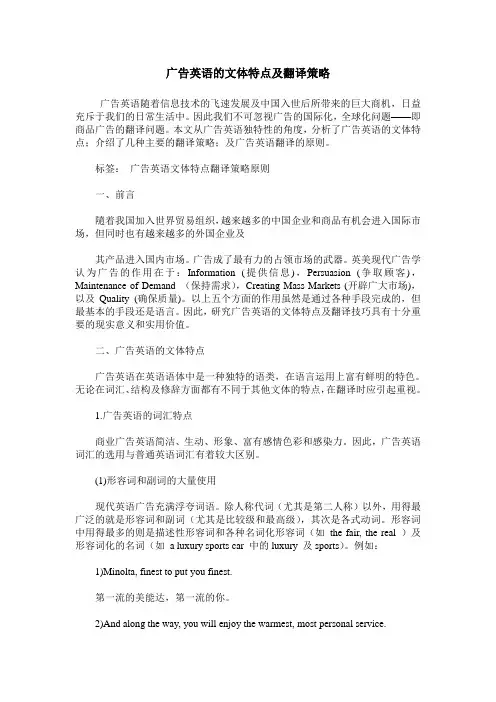
广告英语的文体特点及翻译策略广告英语随着信息技术的飞速发展及中国入世后所带来的巨大商机,日益充斥于我们的日常生活中。
因此我们不可忽视广告的国际化,全球化问题——即商品广告的翻译问题。
本文从广告英语独特性的角度,分析了广告英语的文体特点;介绍了几种主要的翻译策略;及广告英语翻译的原则。
标签:广告英语文体特点翻译策略原则一、前言隨着我国加入世界贸易组织,越来越多的中国企业和商品有机会进入国际市场,但同时也有越来越多的外国企业及其产品进入国内市场。
广告成了最有力的占领市场的武器。
英美现代广告学认为广告的作用在于:Information (提供信息),Persuasion (争取顾客),Maintenance of Demand (保持需求),Creating Mass Markets (开辟广大市场),以及Quality (确保质量)。
以上五个方面的作用虽然是通过各种手段完成的,但最基本的手段还是语言。
因此,研究广告英语的文体特点及翻译技巧具有十分重要的现实意义和实用价值。
二、广告英语的文体特点广告英语在英语语体中是一种独特的语类,在语言运用上富有鲜明的特色。
无论在词汇、结构及修辞方面都有不同于其他文体的特点,在翻译时应引起重视。
1.广告英语的词汇特点商业广告英语简洁、生动、形象、富有感情色彩和感染力。
因此,广告英语词汇的选用与普通英语词汇有着较大区别。
(1)形容词和副词的大量使用现代英语广告充满浮夸词语。
除人称代词(尤其是第二人称)以外,用得最广泛的就是形容词和副词(尤其是比较级和最高级),其次是各式动词。
形容词中用得最多的则是描述性形容词和各种名词化形容词(如the fair, the real )及形容词化的名词(如 a luxury sports car 中的luxury 及sports)。
例如:1)Minolta, finest to put you finest.第一流的美能达,第一流的你。
篇章翻译:广告的翻译
Sony: Hi-fi Hi-fun Hi-fashion only from Sony.
索尼音响:高保真,高乐趣,高时尚,只来自索 尼。
Chevrolet: Future for my future. 雪弗兰: 未来,为我而来。
1. 直译法 2. 转译法 3. 仿译法
广告口号(slogans)、广告语句 (catch-phrases)的特点
吸引力 (attractive --- catch the reader’s attention)
创造力 (creative --- project an image) 说服力 (persuasive --- urge the reader
Sponsor
Media
Persuasive information
products services
ideas
广告英语必须遵循的法则:
AIDMA:
A: attention; I: interest; D: desire; M: memory; A: action.
ห้องสมุดไป่ตู้
广告的功能
广告具有信息功能 (informative function) 美感功能(aesthetic function) 表情功能(expressive function) 祈使功能 (vocative function)
Can't beat the real thing. (可口可乐) 挡不住的诱惑。 Tide's in, dirt's out. (汰渍洗衣粉) 汰渍到,污垢逃。/有汰渍,没污渍。 Apple thinks different. (苹果电脑) 苹果电脑,不同凡“想”。 Not all cars are created equal. (三菱汽车) 并非所有的汽车都有相同的品质。 Anything is possible. (东芝电器) 没有不可能的事。
浅析广告翻译(中英互译)的现状与翻译策略
2492020年02期总第494期ENGLISH ON CAMPUS浅析广告翻译(中英互译)的现状与翻译策略文/杜爽爽构,但词汇却依然一一对译,不考虑上下文。
它主要用来处理一些原文意思较明确、语句结构较简单完整、按字面意思翻译能同时表达句子的表层意思和深层意思的广告词。
2.意译法。
Intelligence everywhere. 智慧演绎,无处不在。
(摩托罗拉手机)意译通常只取原文内容而舍弃其形式,容许译者创造,但原文信息应该保存。
这种方法灵活、自由,翻译过程中考虑到了译文读者因文化差异而产生的阅读和理解上的差异,从读者角度看译文,比较地道,可读性强。
3.创译法。
Music makes us. 生有趣,乐无穷。
创译是将原文的翻译摈弃,进行重新创造。
创译带有一定的创造性,虽然与原文在表层意义上很少有相似之处,但历来被认为是其英文文本的翻版,不是纯粹的创造。
创译出的广告词通常比一般简单的翻译意境更高,感染力更强。
4.增补法。
Crest whitens whites.佳洁士牙膏使牙齿白上加白。
增补法是对原文某些关键词的词义进行挖掘、引申或扩充,将原文的深层意思加以发挥,或使其隐含意义凸现。
因此,译文意思多数超出原文,是典型的超额翻译。
在广告翻译中,必须体现出英汉广告之间存在的差异,但同时必须流畅清晰地传译原文的信息,即译文应使用接受语自然的语言结构,并使译文读者理解广告原文意义时毫不费力。
鉴于英汉两种语言的差异,广告翻译中必须打破一味强调字面对等的积习,或直译或意译,或增译或减译,或创译或不译。
以译文语言文化特点为取向,把握调整的准绳,保证译文的效果。
在翻译广告时,应根据具体广告的不同特点,结合目的语语言和文化的特点,准确、创造性地译成符合目的语读者理解、接受和喜爱的广告,以促进产品的销售。
四、结语广告翻译的成功与否直接影响到企业的形象、产品的声誉及产品的销售。
中外文化之间存在巨大的差异,而广告文体却没有有固定格式。
英语广告的语言特点及翻译策略研究
英语广告的语言特点及翻译策略研究作者:宋海粟来源:《大东方》2019年第03期摘要:随着商品经济的迅速发展,经济全球化的趋势加强,英语广告的翻译越来越重要。
本文将简要分析英语广告的语言特点,并结合具体例子,对英语广告语的翻译策略进行探讨分析,以期促进中国消费者对国外优质产品的了解。
关键词:英语广告;语言特点;翻译策略1.引言如今,中国为世界经济做出的贡献呈逐年上升趋势,世界经济的大舞台也越来越重视中国市场与其产品在中国的宣传力度,所以英语广告的汉译质量有着举足轻重的作用,对英语广告语言特点的认识和把握以及掌握一定的汉译技巧也显得十分必要。
2.英语广告的语言特点(1)词汇特点英语广告中使用的词汇都比较简单,擅长使用非正式语或口语来表达,给人留下深刻的印象,如bye,hello等;英语广告还擅长使用单音节词和合成词,使广告通俗易懂,新颖独特,如have,rich,home-made,first-class等;为了增强英语广告的动感性和形象性,象声词在英语广告中的使用也很普遍,如plop,fizz等;为了使消费者能够对产品产生良好的印象,形容词的比较级和最高级也很受英语广告的青睐,如better,best,hardest等;除此之外,一些创新词汇和外来词汇也经常出现在英语广告中,增强了顾客对商品的好奇心,也迎合了其心理需求。
(2)句法特点英语广告的要求是期待用最简练的语言表达尽可能多的信息,所以英语广告中的句子长度一般都很短,结构简单,复合句较少,并且祈使句和省略句也多出现在英语广告中,因为祈使句有请求和建议的意味,能够起到劝说消费者关注以及购买商品的作用;而省略句的使用能够节约广告的篇幅且有利于广告达到最佳的宣传效果。
除此之外,英语广告也会运用日常生活中大家熟悉的成语或谚语,借用这些美句为广告语言锦上添花。
(3)修辞特点各种各样的修辞手法经常会出现在广告这种文体中。
运用修辞手法的目的在于修辞可以增强语言的表达效果,能够轻松地博得消费者眼球且有一定的说服作用。
广告英语语言特点及其翻译策略
广告英语语言特点及其翻译策略一、广告英语语言特点1. 浓缩精炼广告英语以精炼简洁著称,通过简洁、直接、富有表现力的语言,快速传达产品或服务的信息,并唤起受众的购买欲望。
在广告文本中,常出现一些简短而具有冲击力的口号和标语,例如Nike的"Just do it",可口可乐的"Open happiness"等。
2. 情感化广告英语注重情感表达,通过美学手法和情感色彩,唤起受众的共鸣和共情,引发购买欲望。
广告语言常常运用排比、修辞等修辞手法,以及美丽动人的描绘和夸张的语言来吸引受众的注意力。
3. 诱导性广告英语具有很强的诱导性,其目的是为了促使受众产生购买行为。
广告文本中常常出现一些具有现实诱惑力的词语和句子,如免费、打折、限时优惠等。
4. 社会化广告英语紧跟时代潮流,融入当下社会文化和流行趋势,通过话题热点和时尚元素来吸引受众的注意力。
广告语言也常常运用一些流行俚语和网络语言,使其更容易引起年轻受众的共鸣。
二、广告英语翻译策略1. 保持语言简洁在翻译广告英语时,应力求保持语言的简洁明了,避免翻译过于冗长,以免丧失广告文本原有的冲击力和直接性。
需要注重翻译译文的流畅性和易读性,符合目标受众的阅读习惯和接受程度。
2. 重视情感表达在翻译广告英语时,要注重情感表达,保持译文的美感和感染力,使其能够唤起目标受众的共鸣和共情。
可以通过选择恰当的修辞手法和形象描绘,使译文更具有表现力和感染力。
3. 强化诱导性翻译广告英语时,应注意强化译文的诱导性,突出产品或服务的优势和特点,引导目标受众产生购买欲望。
可以通过选择有诱惑力的词语和句子,保持译文的实用性和现实诱惑力。
4. 结合当地文化在翻译广告英语时,应该结合当地文化和流行趋势,加入适当的话题热点和时尚元素,以吸引目标受众的注意力。
需要注重调整译文的语言风格和文化内涵,使其更符合目标受众的文化背景和习惯。
5. 注重翻译质量在翻译广告英语时,需要注重翻译质量和准确性,确保译文与原文保持一致性和准确性。
- 1、下载文档前请自行甄别文档内容的完整性,平台不提供额外的编辑、内容补充、找答案等附加服务。
- 2、"仅部分预览"的文档,不可在线预览部分如存在完整性等问题,可反馈申请退款(可完整预览的文档不适用该条件!)。
- 3、如文档侵犯您的权益,请联系客服反馈,我们会尽快为您处理(人工客服工作时间:9:00-18:30)。
广告英语的特点及其翻译策略一、我们来看一下什么是广告,它有哪些作用,又是由几个部分组成的。
所谓广告就是一种面向公众介绍商品,服务内容或文体娱乐节目等内容的宣传方式。
一般通过报纸、电视、招贴等方式传播,现在也出现在网络上。
按照它的用途,我们可以把它分为商品广告,公益广告,服务广告等类型。
广告本身是由几个部分构成的,包括标题,正文,口号,商标,附文这五个部分。
而我们在对广告进行翻译时,要强调译文的效果,不仅要提供充分而且易懂的商品信息,还要具有原文的“切肤之感”。
广告翻译最重要的标准就是译文的效果与读者的感受,同时在进行翻译时还要考虑到语言文化的差异,因为广告除了有帮助消费者认识商品的作用外,还有诱发消费者感情,引起购买欲望,促进消费心理的功能,所以从某种意义上来说,能实现广告主要目的的译文就是好译文,要达到预期的商业效果。
二、那么下面我们来看看广告有哪些特点。
由于商品市场竞争激烈为了保证商品的广告可以最大限度的吸引人的眼球,广告商总是选择新颖别致的词汇,简洁的语句和生动的修辞为商品加分,以赢取消费者的享受,广告通常有以下几个特点:lexical, grammatical, rhetoric. 今天我们也从经典英文广告的语言特点,词、句、形来进行简要的分析。
1、经典英文广告的用词特点,①造词新颖,颇具创意。
经典英文广告能给消费者留下深刻的印象。
一部分原因在于它们的词汇别出心裁。
“造词”就是创意之处和魅力所在。
造词有很多的手法,包括添加词缀,拼凑词汇,模仿词汇等。
WWWhat’s new?这是一个网站的广告,我们都知道,互联网网址都以“WWW”开头,这则广告利用添加WW 前缀的方法进行造词,一方面WWW暗示读者这则广告是介绍网站的,另一方面结合“What’s new?”“What are you waiting for?”来吸引读者的注意,是一个非常好的例子。
“The Orangemostest Drink in the world”在这个广告橙汁广告中,用most和est 两个表示最高级的词与orange拼凑在一起,形成了Orangemostest, 暗示这个品牌的橙汁特点就是高浓度、高质量。
这个创造词成为最大的亮点。
②同音词替换,别有风味一些英文广告巧妙的用同音词来达到宣传、促销的目的,十分有趣,颇具风味。
Pay-le$$ , 这个是美国连锁商店佩莱斯的广告,非常巧妙的将less 中的ss 改为美元符号,形象的表现出“本店商品价格优惠”,当然能吸引广大消费者。
下面这个例子是英国某个机场商店的广告“have a nice trip, buy buy”乍一看,好像礼貌用语,“祝你旅途愉快,再见”。
但是仔细一看才发现“bye bye”变成了“buy buy”.这个同音词替换使得机场商店向旅客道别时,也提醒大家购买些商品作为礼物。
③还有一些其他的形式。
比如,韩国LG手机的经典广告,不管是英文广告,还是汉语广告都十分完美,创意独特。
“I chocolate you”句式打破常规,chocolate 名词做动词用,不但点出手机的独特巧克力外表,而且在视觉上和听觉上都给人强烈的印象。
容易引起消费者的兴趣和注意力,而下面的“born to shine”,句式简单却不失大气。
善于玩文字游戏的广告商们,会故意把人们所熟悉的字或者词拼错,形成新词,新词不失原意,更添新意,赋予了广告更大的魅力。
2、我们在看看英文广告的语法特点。
这些特点包括:偏爱简单句,使用祈使句,使用省略句,使用疑问句。
①简单句具有简洁明了,便于记忆、推广型强的特点,因此常用语广告中优秀的商品广告无不以简短精炼而着称。
让我们看下第一个例子。
Coca cola 可口可乐可口可乐中文翻译保持了原词的音节,使人一听就知道是饮料商标,有声有色,回味无穷。
译名的效果甚至超过了原名,是广告翻译的经典。
Sony , take the word with you , 使消费者感觉到Sony 的品牌实力。
下面这张图里有米老鼠、唐老鸭等经典形象,让人想到迪士尼,而迪士尼公园的广告Make dreams come true. 让梦想成真,也使读者体会到童话色彩。
最后一个例子,Time is what you make of it. 天长地久,即说明时间,也宣传了表的经典品质。
②下面我们看下祈使句,我们来欣赏段视频,视频的最后一句话 Ask for more. 渴望无极限。
这个是百事的经典广告。
More 表示更多,翻译成无极限也是对商品的重要性的一种愿望。
我们来看看耐克的广告。
Just do it. 典型的祈使句,与彪马的turn it on,都表达了行文简练又能使人印象深刻的目的。
而祈使句作为鼓动性语言,有利于吸引消费者眼球,引起人们强烈好奇的购买欲。
③下面我们看看祈使句。
省略句结构简单,语言果断有力,能使广告在有限的篇幅中传达更多的信息,加强广告的传播效果。
“我们领先,他人效仿”这则广告只用了“lead”“copy”两个简单的动词,却巧妙的点出其作为复印机的复印功能,和理解品牌在同类产品中的优先地位。
可以说是构思巧妙,一举两得。
而中国电信的“Always with you.”中 always 更形象的表明电信覆盖面广的特点,同时也拉进了与顾客之间的距离。
④巧用疑问句。
疑问句式的特点就是口语色彩浓厚,浅显易懂,具有浓烈的生活气息,没有距离感,引起人们的共鸣的同时,又突出产品特性,润物细无声。
Where do you want to go today?What are luxury car should be?这两则广告都是站在客户立场以问句的形式出现,目的在于引起人们好奇心,吸引读者思考,去寻找答案,What are luxury car should be?看似一个简单问句,其含义是林肯汽车作为顶级汽车品牌,旗下汽车都是顶尖奢华之作。
⑤英文广告语又一大特点在于使用单个名词或词组来描述一个完整的概念,这些单词或词组高度凝聚了商品的特征描写和公司的经营理念,往往能够引人思考,给人想象。
3我们再从下面这六个方面来看看英文广告中所应用的修辞格。
①我们来看看第一个同源修辞,它是指两个或两个以上相似的单词在同一个句中使用。
这个图片是佳洁士的广告,我们看看它的广告语中Chrest whitens whites. 里面有一个white, 又有一个whiten, 使用了这种修辞,增强了广告语的渲染效果,强调商品的使用价值。
②仿拟修辞是通过模仿已有的方式、方法、篇章、格式等表达新的含义,通过耳熟能详的谚语、名言等增强亲切感,使其深入人心。
我们都知道的一个谚语Where there is a will, there is a way. 有志者事竟成。
而丰田汽车的广告Where there is a way, there is a Toyota.正是采用了这个谚语作为广告,是读者有亲切感。
③双关修辞格,是指词或句在特定的条件下拥有两层含义,一层是表义,一层是隐含意。
恰当使用双关语,可以使广告语言显得更含蓄、诙谐,同音异形和一次双关在英语广告中常见。
我们看例子里的 O I C, 这是一个眼睛公司的广告,于“Oh, I see. ”谐音。
意味着我看见了。
同时 I see 也使品牌和眼镜产品质量巧妙的结合在一起。
I‘m More Satisfied. Ask for More. 这是一个双关的典范。
摩尔香烟的广告巧妙的使用了more 这个词的双重含义。
“more”既表示更加,大写之后是商品的品牌。
消费者很容易讲摩尔香烟与“更多”的词义联合起来,直接宣传香烟的品牌,又引起消费者购买欲。
④对偶修辞格,结构相似,语义对等或对立是对偶修辞格的特点,它能突破事物的属性和特性。
第一个例子,用了ever, never,使得广告中突出了表的品质,与品牌化。
⑤我们再看看夸张修辞。
为了宣传产品,在消费者心目中树立起形象,广告词难免“言过其实”。
实际上,广告语言中夸张的运用极为广泛,以满足人们猎奇的心理。
例子里面最后一个东芝广告语,与world 结合使用,使消费者看见了这个品牌的全球实力。
两则广告使用了夸张,巧妙的体现了商品非凡的品质。
⑥最后一个比喻修辞,包括明喻、暗喻、拟人等,也能增加语言的魅力和表现力,给消费者带来好感。
Home is where the Honda is. 这是一个暗喻,把本田车比喻为家。
Apple thinks different. 这里把Apple 赋予了生命,是一种拟人的手法。
三、以上研究了广告的词、句、形。
下面我们要明确一点,广告英语的另一种特点就是在任何文化背景下,广告功能是一致的,都是刺激消费者的购买欲望,使其消费。
我们在翻译之前,还要了解一些中国文化与外国的差异。
从而避免出现不必要的错误。
1、我们来看看第一个语音效果的差异,它能产生不同的听觉效果,在不同的语言文化背景下,同样的语音,会引起不同的效果和反应。
例如东芝公司曾用过一条广告语,一些年轻人开玩笑念谐音,成了“偷去吧,偷去吧,大家的东西。
”2、语义联想差异。
语言是文化的一部分,又是文化的载体,它反映着民族的特征。
不仅包含着民族的历史和文化背景,而且也蕴含着该民族对人生的看法,生活方式和思维方法。
例如,上海产的白翎钢笔,翻译成英文white feather,但是却在英语国家无人问津,因为,To show the white feather 是临阵逃脱,胆小鬼的意思。
3、修辞含义的文化差异,广告中的修辞使表达的内容形象化、具体化或使主要词语鲜明突出,加强语言效果,但若掌握不好也会出错。
我们都知道白象方便面,翻译成英文很自然就会想到是“white elephant”,“a white elephant”是固定用语,在英文中式沉重的负担,无用累赘,所以不能想当然。
我们看例子里的这个夏普的广告,非常的经典,运用了双关,表明产品性能好,高科技。
另外,spirite,雪碧,也是非常成功的例子,汉字配上饮料的味道,给人清爽,舒畅的感觉。
同样的“clean and clear”,也采用了谐音的翻译。
四、我们了解了这么多,下面我们就来看看广告翻译的策略。
直译或者叫异化翻译,意译,增补形翻译。
1、首先我们来看下直译,把原来语言的语法结构转译成译文语言最近似的结构,保留原文的格式,和原文的语言特色。
读起来虽然可能不像母语原创流程,但是所表达的信息非常明确。
2、意译,翻译手法比较自由、灵活,翻译过程中通常考虑到译文目标读者理解差异。
因此,不拘泥于广告原文的形式,从读者的角度看比较地道,可读性比较强。
我们的例子中ask for more, 我们翻译成渴望无极限。
在某种程度上,意译虽然表达了原文的句式结构,一些关键词也有出入,但原广告词的精髓或深意得以保留。
